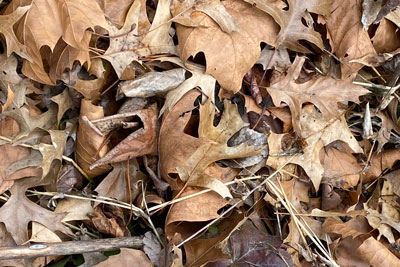
By Linda Wiggen Kraft, Healthy Planet Green & Growing Editor
There is a cycle, a circle of life, that cannot be broken if we love birds, bees, and insects that are necessary for the ecosystem of life. This cycle of life is often broken when we do killer cleanups of our garden beds.
What is a killer cleanup? Insects overwinter in leaf litter and plant stems. If the typical garden cleanup of removing leaves and cutting back stems is done anytime before the insects have emerged from their winter and early spring refuge, the cycle of garden life is broken. Cleanups kill insects if done too early. Those insects include caterpillars that birds need to feed their young. Baby birds can only be fed caterpillars. No caterpillars, no birds. Native bees, beneficial and other insects need the shelter of fallen leaves and winter stems for winter protection.
Most of us have gotten the message about the need to plant native plants. But often, the message about the need to leave these plants in the state they would be in winter and early spring without our cleanup intervention is missing. As important as the flowering stage of a native plant is for insects, all the other stages of that plant’s life are just as important. The seeds provide food for wildlife. The stems are often winter homes for insects. The fallen leaves provide protection. A plant’s new growth will feed the emerging insects as they become food for birds and wildlife. Some of the emerging insects go on to pollinate the plants. The cycle of life goes on.
Native plants provide nectar and pollen for pollinators. They are also host plants meaning certain insects will lay their eggs on certain plants. The eggs hatch, eat some of that plant, and both go on with their lives. An example is the monarch butterfly that lays eggs only on milkweed (asclepias) plants. The eggs hatch and eat enough of the leaves for both the monarch caterpillar’s and the plant’s survival. Monarchs are unusual in that they migrate to warmer climates in the winter, most insects stay here and don’t migrate. Their life cycle continues in winter and early spring in the fallen leaves and plant stems.
Luna and other moths wrap their cocoons in leaves in the fall. Swallowtail butterflies create a chrysalis that looks like dried leaves attached to branches. These and other cocoons and chrysalises over winter amongst fallen leaves and on nearby branches. Cleanups before the butterflies and moths emerge break the cycle of life and destroy these lovely insects.
When can garden cleanups take place? Leaves can be removed from lawns and driveways in the fall and winter. If possible, don’t dispose of them, find an area where these leaves can be piled and insects can emerge in the spring. These leaves can be used for mulch later. Leaves and garden growth in garden beds should be left over the winter and into spring. When daytime temperatures are consistently above 50 degrees for a week of consecutive days, then garden cleanup can take place and mulch put down.
There are several months before spring cleanups can be done that help with insect survival. Resist the urge to clean up before insects can go on to their next stage of life. In the meantime, learn to enjoy looking at the leaves and winter stems in your gardens, knowing they are the winter and early spring homes of important and lovely Insects and garden life.
Linda Wiggen Kraft is a landscape designer of holistic and organic gardens. She is also an artist and creativity workshop leader. Her next art workshop will be summer 2023. Find out more, subscribe to her blog and Instagram at www.CreativityForTheSoul.com, Call her at 314 504-4266.


